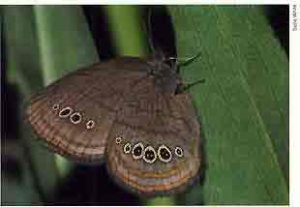Introduction
The diversity of wildlife habitats throughout our country is surprising. In rural areas, fence rows, fields, pastures, ponds, wetlands, and woodlands comprise important habitats for many species of wildlife. Wild species also inhabit urban landscapes, finding food and shelter in lawns, cemeteries, golf courses, parks, etc. Collectively, these habitats (urban, rural, public forest, and pristine areas) provide resources to support plants (flora) and animals (fauna) that are important and necessary.
Lands that provide habitat for wildlife also may bring them into contact with human activities. Wildlife species living adjacent to farmlands may benefit from the crops grown but may be inadvertently exposed to pesticides used to reduce insect, weed, and disease pests of those crops. Urban expansion for new housing, manufacturing facilities, and other activities not only consumes valuable habitat, but also may bring wildlife into contact with pesticides used on turf, ornamental and landscape plantings, gardens, highway rights-of-way, parks, and rodent and mosquito abatement programs. Pesticides and Wildlife introduces its readers to the potential effects of pesticides on wildlife and aquatic organisms; to the process by which ecological safety assessments are made for registered pesticides; and to pesticide use recommendations to protect wildlife.
Benefits of Wildlife

Endangered species: Mitchell’s Satyr (Euptychia mitchellii)
Watching wildlife in natural settings appeals to persons of all ages and all ethnic, educational, and social backgrounds. Eighty-five percent of Americans participate in some wildlife observation activity (e.g., whale, bird, and butterfly watching). Ecotourism has become a lucrative market; many businesses and communities actively advertise and attract tourists to observe wildlife.
Wildlife viewing tours organized by professional wildlife biologists are in demand, and tourism is supported by a cadre of jobs related to lodging, meals, transportation, art, equipment, and the media. Taxes dedicated from the sale of hunting and fishing licenses, and certain outdoor equipment, provide revenue to purchase, maintain, and restore wildlife habitats while monetary support from some government agencies is dwindling. These user-based taxes also help finance scientific research on wildlife communities. It is important that we, as a society, do all we can to maintain and preserve the natural world and benefit from its existence.
Fewer than 20 plant species are responsible for feeding most of the world’s population. However, it is estimated that 80,000 species of edible plants may have potential as new food sources; and wild plant and animal species may become sources of new genetic material with agricultural or medical applications. For example, the purple cone flower (a native prairie plant) has an oilseed content greater than that of commercially grown sunflowers; and the South American corn variety Zea diploperennis has been used to breed resistance to northern corn leaf blight into North American corn hybrids, thereby curtailing the likelihood of a major blight outbreak, which might impact grain markets. Plants (e.g., Pacific Yew, which produces taxol) and animals also have been shown to harbor an array of pharmaceutical chemicals whose medicinal properties may be used to combat disease. Wildlife also play a role as natural enemies of pest species (e.g., birds eat mosquitoes; snakes consume rodents).
Many of these relationships are known, but many are yet to be discovered. It is for this reason that we must ensure that the vast array of plants and animals on our planet are maintained for future generations. It is likely that important connections exist between species diversity, environmental quality, and the long-term sustainability-and profitability-of farming operations.
Authored by Fred Whitford, et al.

The above information is the property of Purdue University, reprinted from Pesticides and Wildlife, PP-30. All information on authors and disclaimers relative to the use of this information can be found at that address.